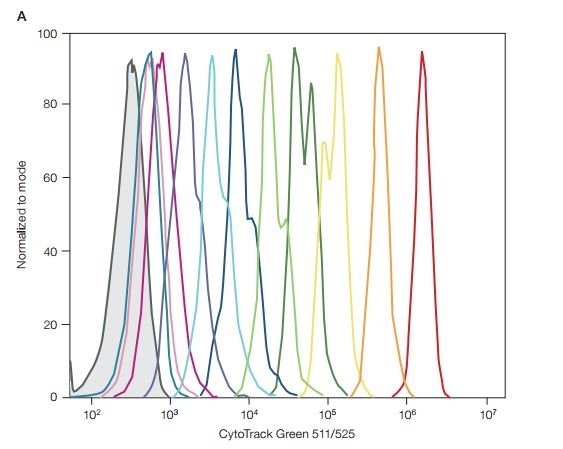CYTOTRACK™




CYTOTRACK™ Blue 403/454 Cell Proliferation Assay Kit
- Product Type
- Accessory Reagent
- Specificity
- CYTOTRACK™
| CytoTrack cell proliferation assay kits are available in three distinct dyes for easy multicolor cell analysis: blue, green and red. Easily incorporate a cell tracking stain into your multicolor panel. The proprietary chemistry of CytoTrack dyes enables the resolution of up to ten cell divisions. Each dye is cell permeable and comprises a fluorophore, a fluorescence blocker and a cell-retaining group. Upon entering a live cell, the fluorescence blocker is cleaved by intracellular esterases and the cell-retaining group of the fluorophore reacts with intracellular proteins to create a stable, covalent bond. As the cells divide, the fluorescence intensity is successively halved and each cell divison can be identified. |
- Reagents In The Kit
- CytoTrack Dye (4 vials, 50 assays/vial)
DMSO (1 vial, 250 μl) - Regulatory
- For research purposes only
- Guarantee
- Guaranteed until date of expiry. Please see product label.
This product is photosensitive and should be protected from light
| Application Name | Verified | Min Dilution | Max Dilution |
|---|---|---|---|
| Flow Cytometry | 1/500 |
- Instructions For Use
- Important: Thaw all components prior to use.
1. Prepare a 500x stock solution. Add 50 μl of DMSO and mix.
2. Protocol for use in culture medium (for product 1351203) - Add 1 μl of stock solution into 500 μl of media containing 1 x 106 cells of interest.
Protocol for use with buffer (for products 1351202, 1351203 and 1351205) - Prepare a 1x working solution. Add 1 μl of stock solution into 500 μl of buffer, pH 7. Add 500 μl of 1x solution to 1 x 106cells.
3. Incubate at room temperature for 15 mins. Protect from light.
4. Pellet the cells by centrifugation.
5. Remove the supernatant and wash the cells using 3 ml of fresh prewarmed culture media.
6. Resuspend the cell in 500 μl of culture media.
7. Place the cells in the appropriate conditions for cells proliferation.
8. Harvest the cells and stain them for other markers if appropriate.
9. Analyze or sort the cells using a flow cytometer or S3e cell sorter with the appropriate excitation and emission filters.
References for CYTOTRACK™
-
Perrotta, C. et al. (2018) Nitric Oxide Generated by Tumor-Associated Macrophages Is Responsible for Cancer Resistance to Cisplatin and Correlated With Syntaxin 4 and Acid Sphingomyelinase Inhibition.
Front Immunol. 9: 1186. -
Perrotta, C. et al. (2016) Climacostol reduces tumour progression in a mouse model of melanoma via the p53-dependent intrinsic apoptotic programme.
Sci Rep. 6: 27281. -
Zecchini, S. et al. (2019) Autophagy controls neonatal myogenesis by regulating the GH-IGF1 system through a NFE2L2- and DDIT3-mediated mechanism.
Autophagy. 15 (1): 58-77. -
Saito, Y. et al. (2020) Exercise enhances skeletal muscle regeneration by promoting senescence in fibro-adipogenic progenitors.
Nat Commun. 11 (1): 889. -
Cappello, P. et al. (2016) Anti-α-enolase antibody limits the invasion of myeloid-derived suppressor cells and attenuates their restraining effector T cell response.
Oncoimmunology. 5 (5): e1112940. -
Tario, J.J. et al. (2018) Monitoring Cell Proliferation by Dye Dilution: Considerations for Probe Selection.
Methods Mol Biol. 1678: 249-99. -
Loef, E.J. et al. (2021) Live-Cell Microscopy Reveals That Human T Cells Primarily Respond Chemokinetically Within a CCL19 Gradient That Induces Chemotaxis in Dendritic Cells.
Front Immunol. 12: 628090. -
Wang, X. et al. (2021) Activatable Biomineralized Nanoplatform Remodels the Intracellular Environment of Multidrug-Resistant Tumors for Enhanced Ferroptosis/Apoptosis Therapy.
Small. : e2102269.
View The Latest Product References
Please Note: All Products are "FOR RESEARCH PURPOSES ONLY"
Always be the first to know.
When we launch new products and resources to help you achieve more in the lab.
Yes, sign me up


